Hiking shoes come in different shapes and weights. From trail runners to lightweight boots. Hiking boots have been around since the dawn of hiking, but they are not your only option when you hit the trails. Many hikers now choose to wear low-cut footwear that takes the best of a boot and mixes it with a running shoe.
We tested the best hiking shoes on the market for 2024. Read on to see which models are best for you and get some buying advice.
Table of Contents
Best Hiking Shoes
The best hiking shoes are:
- Best Overall Hiking Shoe: BROOKS CASCADIA 16
- Best Lightweight Hiking Shoe: SAUCONY PEREGRINE 12
- Best Budget Hiking Shoe: MERRELL MOAB 3
- Best Zero Drop Hiking Shoe: ALTRA LONE PEAK 6
- Best Waterproof Hiking Shoe: SALOMON X ULTRA 4 MID GORE-TEX
- Best Rugged Trail Running Shoe: SALOMON XA PRO 3D V8
| MODEL | PRICE | Type | Weight (per pair) | Heel to Toe Drop | Shoe Sole | Material | Score |
|---|---|---|---|---|---|---|---|
| 1. Brooks Cascadia 16 | $130 | Trail Runner | 21 oz | 8 mm | DNA LOFT V2; Trailtack; Rubber; Rock Plate | Synthetic (Lining), Synthetic Mesh (Upper) | 9/10 |
| 2. Saucony Peregrine 12 | $130 | Trail Runner | 19.4 oz | 4 mm | PWRRUN; PWRTRAC Rubber; 5mm; Rock Plate | Recycled Polyester Air-Mesh | 9/10 |
| 3. Merrell Moab 3 | $110 | Hiking Shoe | 33 oz | 11.5 mm | Super Rebound Compound; Vibram TC5+ Outsole; 5mm | Pigskin Leather / Mesh | 9/10 |
| 4. Salomon XA Pro 3D V8 | $130 | Trail Runner | 24 oz | 11 mm | Energycell; Contagrip Rubber; 3.5 mm | Ortholite, Synthetic / Textile | 9/10 |
| 5. Altra Lone Peak 6 | $140 | Trail Runner | 21.2 oz | 0 mm | Altra EGO; Maxtrac | Quick-Dry Air Mesh | 8/10 |
| 6. Hoka One Speedgoat 5 | $155 | Trail Runner | 20.6 oz | 4 mm | CMEVA; Vibram Megagrip Rubber With Traction Lug | Mesh (Upper) | 8/10 |
| 7. Salomon X Ultra 4 Mid Gore-Tex | $165 | Trail Runner | 30 oz | 11 mm | Energycell; Contagrip Chassis Rubber | PU Coated Leather / Textile | 8/10 |
| 8. Oboz Sawtooth X Low | $150 | Hiking Shoe | 33.8 oz | 15 mm | Heel Puck; Rubber-Blended Adaptive Foam; True Tread Rubber | Oiled Nubuck Leather and CORDURA Fabric Mesh | 8/10 |
| 9. Adidas Terrex Ax4 | $100 | Hiking Shoe | 26.2 oz | 10 mm | Dual-Density EVA; Continental Rubber | Mesh and Synthetic Upper | 8/10 |
| 10. Vasque Breeze Low NTX | $160 | Hiking Shoe | 25 oz | 12 mm | Dual-Density Compression-Molded Enduralast EVA; Vibram Ground Control Litebase Rubber | Recycled Mesh / 1.2 Mm Suede / TPU Yarn Mesh | 8/10 |
| 11. Arc'teryx Aerios FL 2 GTX | $180 | Hiking Shoe | 24 oz | 10 mm | Compressed EVA; Vibram Megagrip Rubber | Recycled Polyester | 8/10 |
| 12. Salewa Mountain Trainer 2 | $170 | Approach | 32 oz | 11 mm | Expanded PU; VIBRAM MTN TRAINER EVO | Suede Leather, Full Rubber Rand (Upper); Mesh (Lining) | 8/10 |
| 13. KEEN Targhee III WP | $165 | Hiking Shoe | 32.2 oz | no info | Dual-Density EVA; KEEN.ALL-TERRAIN Rubber | Oiled Nubuck Leather (Upper); Mesh (Lining) | 8/10 |
| 14. La Sportiva Wildcat 2.0 | $165 | Trail Runner | 28.4 oz | 12 mm | Memiex / Nylon; Rubber | Gore-Tex Lining, Nylon Air Mesh / Polyurethane Reinforcements Upper | 7/10 |
| 15. La Sportiva Ultra Raptor II | $155 | Trail Runner | 25 oz | 9 mm | Injection-Molded Memlex; Endurance Platform EVA Inserts; Frixion XF 2.0 X-Axis Rubber; Rock Plate | Airmesh (Upper), Mesh (Lining | 7/10 |
| 16. Danner Trail 2650 | $190 | Hiking Shoe | 24 oz | 8 mm | EVA; Outsole: Vibram® 460 | Leather / Textile Upper, Mesh Lining | 7/10 |
| 17. The North Face Ultra Fastpack IV FUTURELIGHT | $159 | Trail Runner | 25.4 oz | 12 mm | Fastfoam; Vibram Megagrip Rubber | Abrasion-Resistant Mesh | 7/10 |
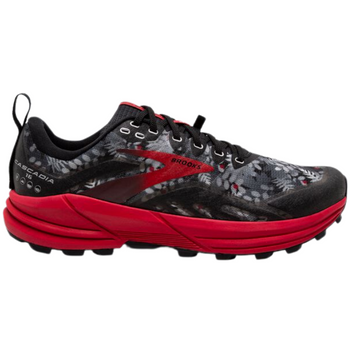
PROS:
✅ More durable than other trail runners
✅ Inexpensive
✅ Best overall hiking shoe
CONS:
❌ Less durable than hiking shoes
KEY SPECS
- Type: Trail Runner
- Weight (per pair): 21 oz (1.31 lbs)
- Heel-to-Toe Drop: 8 mm
- Shoe Sole: Midsole: DNA LOFT V2; Outsole: Trailtack; Rubber; Rock Plate
- Material: Synthetic (Lining), Synthetic Mesh (Upper)
The Brooks Cascadia 16 is the latest version of the ever-popular Cascadia line. The trail runner is a stiff, form-fitting shoe with a heavy-duty rock plate that'll help you cruise over rocky terrain. For us it wasn’t quite as cushioned as the Altra Lone Peak or Hoka Speedgoat but we like that it provides more stability and protection from scuffs, scrapes, and toe stubs. The 8-millimeter toe drop is larger than some models, which can be good or bad depending on your personal preference.
Initially we were leery of the new Cascadia, we’ve found previous versions have been plagued by durability issues. We’re happy to report that for the 16’s, these issues have been fixed. It’s now more durable than other trail runners, but as a trail runner durability is still on the low end. With its excellent balance of features, the Cascadia is our pick for the best overall hiking shoe.
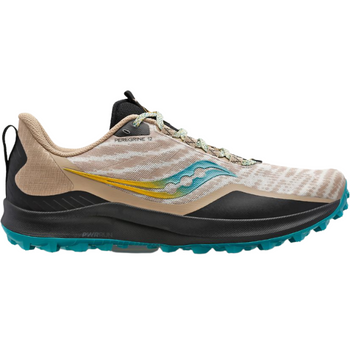
PROS:
✅ Ultralight
✅ Excellent traction and support
✅ Inexpensive
CONS:
❌ Durability
KEY SPECS
- Type: Trail Runner
- Weight (per pair): 19.4 oz (1.21lbs)
- Heel-to-Toe Drop: 4 mm
- Shoe Sole: Midsole: PWRRUN; Outsole: PWRTRAC Rubber; Lug Height: 5mm; Rock Plate
- Material: Recycled Polyester Air-Mesh
The Saucony Peregrine is one of our long-time favorites. We like this solid all-around shoe for its outstanding stability and extra grippy traction. The Peregrine 12 featured major design updates, most notably making them even lighter. At 19.4 ounces per pair, they are now the lightest trail running shoes for hiking on our list.
We like that in the new design they’ve tweaked the traction and increased the breathability of the mesh uppers. Durability, like many trail running shoes, is the Achilles heel of the Peregrine. The Peregrine is our pick for the best lightweight hiking shoe.
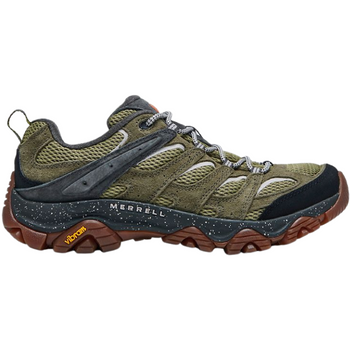
PROS:
✅ Low cost
✅ Excellent durability
CONS:
❌ Heavy
KEY SPECS
- Type: Hiking Shoe
- Weight (per pair): 33 oz (2.06 lbs)
- Heel-to-Toe Drop: 11.5 mm
- Shoe Sole: Midsole: Super Rebound Compound; Outsole: Vibram TC5+ Outsole; Lug: 5mm; Support: Molded Nylon Arch Shank
- Material: Pigskin Leather/Mesh
The Merrell Moab 3 may not be the lightest hiking shoe on the market, but that shouldn't deter you from considering these classic backpacking shoes. The trade-off in weight is a rugged and durable shoe that will last a long time. We like that the shoe itself features strong leather construction and a rubber toe cap for protection.
They have less traction than other shoes on our list, but they offer great stability due to the wider fit. The price is one of the lowest on our list, making these our top-budget buy. The price is even more impressive when you consider they should last at least 2-3 times as long as trail running shoes.

PROS:
✅ Thru-hiker favorite
✅ Wide toe box
✅ Comfy
CONS:
❌ Durability
KEY SPECS
- Type: Trail Runner
- Weight (per pair): 21.2 oz (1.33 lbs)
- Heel-to-Toe Drop: 0 mm
- Shoe Sole: Midsole: Altra EGO; Outsole: Maxtrac
- Material: Quick-Dry Air Mesh
The new version of the Altra Lone Peak 6 lives up to its predecessor's reputation. We like that it comes with the Altra standards like zero drop, generous cushioning, and a wide toe box. We found in this latest version the toe box was slimmed a bit. The overall fit can be wide and not for those who prefer a close-fitting shoe. It's an extremely comfortable trail runner for hiking with ample cushioning and plenty of ventilation.
It has a lugged sole that provides good traction on everything from rock slabs to mud. Our biggest gripe is the Lone Peak's durability. While the upper and the cushioning will last, the sole wears down faster than we like. The Lone Peak 6 is our pick for best zero-drop hiking shoe.
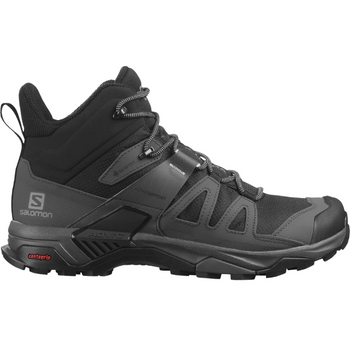
PROS:
✅ Great traction and support
✅ Waterproof
✅ Comfortable
CONS:
❌ Expensive
❌ Heavy
KEY SPECS
- Type: Trail Runner
- Weight (per pair): 30 oz (1.88 lbs)
- Heel-to-Toe Drop: 11 mm
- Shoe Sole: Midsole: Energycell; Outsole: Contagrip Chassis Rubber
- Material: PU Coated Leather/Textile
The Salomon X Ultra 4 GTX occupies a middle ground between trail running shoes and light hiking shoes like the Merrell Moab 3. We found it to be very durable and comfortable with a cozy cushioned fit. What really stands out for us with the Ultra 4 is the incredible traction along with Gore-Tex waterproofing. We love this shoe for wet and muddy conditions.
At just under two pounds it’s one of the heavier options on our list. The price tag is also on the expensive side. The Salomon X Ultra 4 Mid-Gore-Tex is our top pick for best waterproof hiking shoe.
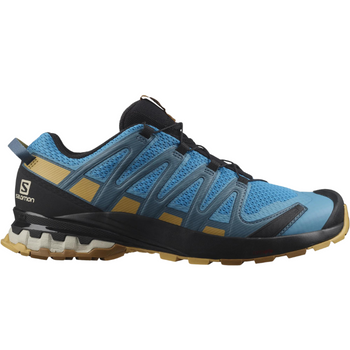
PROS:
✅ Excellent traction
✅ Durable
✅ Responsive
CONS:
❌ Less comfortable than other trail runners
KEY SPECS
- Type: Trail Runner
- Weight (per pair): 24 oz (1.50lbs)
- Heel-to-Toe Drop: 11 mm
- Shoe Sole: Midsole: Energycell; Outsole: Contagrip Rubber; Lug Depth: 3.5 Mm; Support: Chassis
- Material: Ortholite, Synthetic / Textile
Think of the Salomon XA Pro 3D V8 as a beefed-up trail running shoe designed to give you maximum grip and stability. We like that it also offers good durability and protection while hiking on the trail. We found the fit of these shoes to be tight. This lets you feel every movement, making the shoe extremely responsive.
We recommend trying these on before you buy to ensure you get the correct size, as there is no extra wiggle room. They come in a touch heavier than other trail running shoes and we noticed less cushy comfort. If you want a rugged trail running shoe for hiking, this is our pick.
The Other Noteworthy Models

PROS:
✅ Ultralight
✅ Superior comfort
CONS:
❌ Durability
KEY SPECS
- Type: Trail Runner
- Weight (per pair): 20.6 oz (1.29 lbs)
- Heel-to-Toe Drop: 4 mm
- Shoe Sole: Midsole: CMEVA; Outsole: Vibram Megagrip Rubber With Traction Lug
- Material: Mesh (Upper)
If you want a shoe designed to go fast and light, the Hoka One Speedgoat 5 is for you. These shoes are ultralight and we love that they feature tons of cushioning to let you crush the miles in comfort. They offer plenty of traction for most trails but are not as good models designed for more rugged or off-trail use.
For us, the fit of these shoes straddles the middle ground in width and offers plenty of room to wiggle your toes, but not so much that they slide around. We found the Speedgoat 5’s biggest drawback is its sub-par durability.
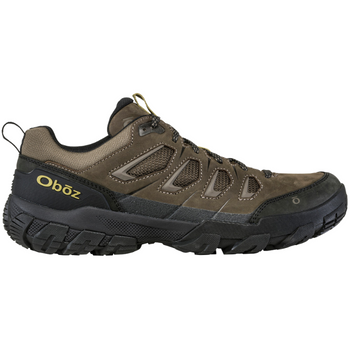
PROS:
✅ Durable
✅ Excellent protection from debris
CONS:
❌ Heavy
KEY SPECS
- Type: Hiking Shoe
- Weight (per pair): 33.8 oz (2.11 lbs)
- Heel-to-Toe Drop: 15 mm
- Shoe Sole: Midsole: Heel Puck; Rubber-Blended Adaptive Foam; Outsole: True Tread Rubber; Support: Nylon Shank
- Material: Oiled Nubuck Leather And CORDURA Fabric Mesh
The Sawtooth X Low from Oboz is as close to a boot as you will find in a hiking shoe. We found the outer nubuck leather and abrasion-resistant mesh stand up well to abuse. We like that it has a toe cap for protection from roots and rocks and a heel shank for added stability.
These definitely have the feel of hiking boots to us. We like that the tread grips exceptionally well on the downhills and dry rock but we found they tend to slip in wet conditions. The Oboz is the heaviest shoe on our list.
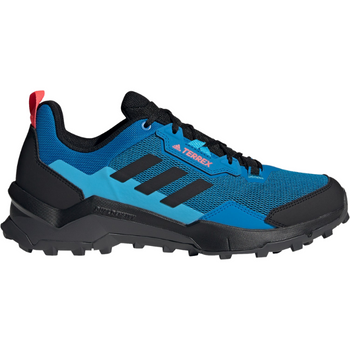
PROS:
✅ Inexpensive
✅ Good all-around value
CONS:
❌ Heavier
KEY SPECS
- Type: Hiking Shoe
- Weight (per pair): 26.2 oz (1.64lbs)
- Heel-to-Toe Drop: 10 mm
- Shoe Sole: Midsole: Dual-Density EVA; Outsole: Continental Rubber
- Material: Mesh And Synthetic Upper
An affordable option from Adidas, we found the Terrex AX4 to be best suited for a more leisurely day hike or light trail running. The black color and casual look means you can wear them on the trail and in the grocery store. But don't be fooled; we like that the tread on the Terrex AX4 is top-notch made from continental tire rubber and a lug pattern designed for gripping rugged terrain.
We found them to be a bit heavier than we would like. As the least expensive shoe on our list they are a nice go-to if you’re looking for an all-around shoe.

PROS:
✅ Durable
✅ Waterproof
✅ Sample
CONS:
❌ Heel slips out of the box
KEY SPECS
- Type: Hiking Shoe
- Weight (per pair): 25 oz (1.56 lbs)
- Heel-to-Toe Drop: 12 mm
- Shoe Sole: Midsole: Dual-Density Compression-Molded Enduralast EVA; Outsole: Vibram Ground Control Litebase Rubber
- Material: Recycled Mesh/1.2 Mm Suede/TPU Yarn Mesh
The Vasque Breeze is a hybrid of a trail running shoe and a traditional leather hiking shoe. We like that the uppers are constructed with breathable mesh and moisture-wicking materials to reduce sweat. The waterproof Gore-Tex membrane kept our feet dry from the elements.
We found these shoes have more stiffness than trail runners but are more flexible than chunkier hiking shoes. We discovered some heel slip right out of the box, but after a bit of breaking in it disappeared.
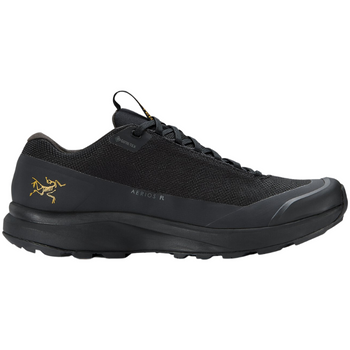
PROS:
✅ Comfort
CONS:
❌ Expensive
KEY SPECS
- Type: Hiking Shoe
- Weight (per pair): 24 oz (1.50 lbs)
- Heel-to-Toe Drop: 10 mm
- Shoe Sole: Midsole: Compressed EVA; Outsole: Vibram Megagrip Rubber; Support: Injected TPU Shank, 70 Shore D
- Material: Recycled Polyester
With its minimalist design, the Arc'teryx Aerios FL GTX doesn't look like a hiking shoe, but it performs like one. It is lightweight and cushioned with a sneaker-like feel. We were impressed with the top-notch construction, but you'll pay for it.
The Arc'teryx Aerios FL GTX is one of the most expensive hiking shoes on our list. What you'll get for that extra cash is a Cordura mesh upper with an outer protective layer that resists abrasion, Vibram mega grip soles, and a footbed with ample cushioning. We found that the Aerios FL GTX tends to run small, much like an approach shoe, so keep that in mind if you have wide feet.

PROS:
✅ Grippy sole
CONS:
❌ Heavy
KEY SPECS
- Type: Approach
- Weight (per pair): 32 oz (2 lbs)
- Heel-to-Toe Drop: 11 mm
- Shoe Sole: Midsole: Expanded PU; Outsole: VIBRAM MTN TRAINER EVO
- Material: Suede Leather, Full Rubber Rand (Upper); Mesh (Lining)
The Salewa Mountain Trainer 2 is an approach shoe for rock climbing, but we like that it can double as a hiking shoe. What sets the Salewa apart is its stiff nylon shank and rugged Vibram sole. We found the nylon shank provided ample support and protection from roots and rocks.
The sole is long-lasting with a heel brake to prevent slipping when walking downhill. Thanks to the treads' extreme griping; we could walk confidently on slippery, steep, or rocky terrain. Being rock climbing style shoes we noticed a more narrow fit. They also come in quite heavy at two pounds per pair.
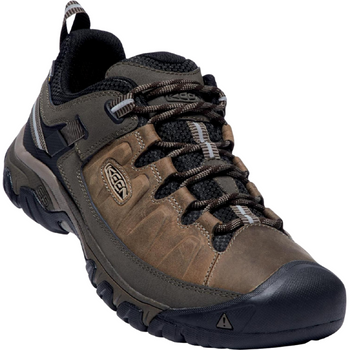
PROS:
✅ Durable
✅ Waterproof
CONS:
❌ Heavy
KEY SPECS
- Type: Hiking Shoe
- Weight (per pair): 32.2 oz (2.01 lbs)
- Heel-to-Toe Drop:
- Shoe Sole: Midsole: Dual-Density EVA; Outsole: KEEN.ALL-TERRAIN Rubber
- Material: Oiled Nubuck Leather (Upper); Mesh (Lining)
The Keen Targhee III is a classic hiking shoe design with a sturdy leather outer, moderate cushioning, and a wide, roomy fit. We like that the Targhee III provides a good grip on steep terrain thanks to its tread pattern and side lugs for extra stability.
We found the leather/mesh upper is stiff and requires some breaking in. They are also waterproof and the thicker design is warmer, great for the spring thaw and rainy fall days when keeping your feet warm and dry is critical. We don’t like the bulkier design, making them the second heaviest shoe on our list.

PROS:
✅ Traction
✅ Breathable
CONS:
❌ Price
❌ Weight
KEY SPECS
- Type: Trail Runner
- Weight (per pair): 28.4 oz (1.78lbs)
- Heel-to-Toe Drop: 12 mm
- Shoe Sole: Midsole: Memiex / Nylon; Outsole: Rubber
- Material: Gore-Tex Lining, Nylon Air Mesh/Polyurethane Reinforcements Upper
The La Sportiva Wildcat 2.0’s have been a mainstay as trail running shoes for hiking. We like the thin mesh uppers that are ultra-breathable. However, we don’t like that these thin mesh uppers can rip easily. Overall, we wish these shoes were more durable.
They have less protection for your toes than some hiking shoes but sit squarely in the middle of our picks for overall comfort. Weight and price are where these shoes get tripped up. They sit near the bottom of both categories.
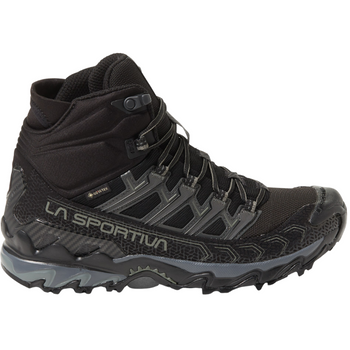
PROS:
✅ Superior traction
CONS:
❌ Durability
❌ Uncomfortable
KEY SPECS
- Type: Trail Runner
- Weight (per pair): 25 oz (1.56 lbs)
- Heel-to-Toe Drop: 9 mm
- Shoe Sole: Midsole: Injection-Molded Memlex; Endurance Platform EVA Inserts; Outsole: Frixion XF 2.0 X-Axis Rubber; Rock Plate
- Material: Airmesh (Upper), Mesh (Lining
The La Sportiva Ultra Raptor II is another beefy trail running shoe, in the same vein as the Salomon XA PRO 3D V8. We found it had excellent traction to grab onto rocks and uneven terrain. It’s in the middle of the models we reviewed for both price and weight.
Although most trail runners for hiking tend to be comfy, we found the Raptor II to be the outlier in this category. Durability wise it’s an improvement over some trail runners, like the Altra Lone Peak 6, but still leaves a lot to be desired.
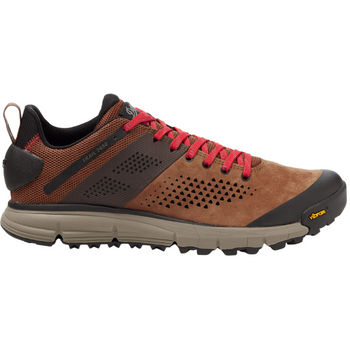
PROS:
✅ Stylish
✅ Comfortable
✅ Breathable
CONS:
❌ Expensive
KEY SPECS
- Type: Hiking Shoe
- Weight (per pair): 24 oz (1.50 lbs)
- Heel-to-Toe Drop: 8 mm
- Shoe Sole: Midsole: EVA; Outsole: Vibram® 460
- Material: Leather/Textile Upper, Mesh Lining
The Trail 2650 from Danner is a lightweight, comfortable hiking shoe for trail and walking around town. We found the design to be unique. It pairs a durable leather upper over the front of the foot and mesh along the back and sides. On the inside, we like the mesh liner with perforations in the outer leather for increased breathability.
Bonus points: the Danner is stylish enough for us to wear around town if you want to head straight from the trail to a cafe. However, that style comes with the heftiest price tag on our list making it tough to choose over cheaper and more functional options.
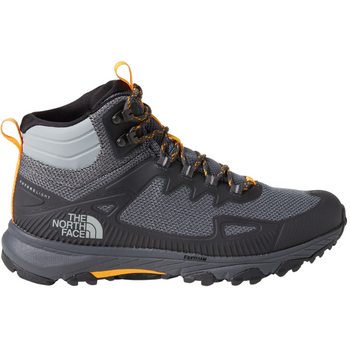
PROS:
✅ Waterproofing
CONS:
❌ Uncomfortable
KEY SPECS
- Type: Trail Runner
- Weight (per pair): 25.4 oz (1.59lbs)
- Heel-to-Toe Drop: 12 mm
- Shoe Sole: Midsole: Fastfoam; Outsole: Vibram Megagrip Rubber; Support: ESS Shank
- Material: Abrasion-Resistant Mesh
The North Face Ultra Fastpack IV is classified as a trail runner, but it leans closer to a light hiking shoe, thanks to its chunkier design. If you are the type of person who stubs their toes, we like the Futurelight’s thick toe guard. It offers good waterproofing with a DryVent membrane lining the mesh uppers.
Overall, it scores in the middle of most of our categories. We recommend this shoe for those wanting a shoe that looks nice enough in town and can also handle day hikes on the weekend.
Key Factors To Consider When Choosing
Price
The cost of hiking shoes and trail runners is around $100 on the low end and upwards of $200 on the high end. Hiking shoes tend to be more durable than trail runners, meaning fewer replacement costs over time. If you love a specific model, we recommend checking the price and availability of the prior year's model. They are often nearly half the price of the current year's model and are often similar shoes.
Hiking shoes that provide the greatest value:
Affordable hiking shoes:
Premium hiking shoes (most expensive):
Weight
The move away from full hiking boots has been fueled by better shoe technology and studies that show weight on your feet fatigues you much more than weight on your back. We recommend hiking shoes that are two pounds or less. Low hiking boots are heavier than trail runners and provide a good middle ground for those switching from traditional boots. Trail runners are the go-to for those wanting to go as ultralight as possible.
The lightest hiking shoes:
Traction & Support
Good traction and support are crucial for a hiking shoe, especially in rugged terrain. Traction comes from the lug pattern. Deep lugs provide exceptional footing in mud and loose dirt, while shallow lugs perform best on hard-packed trails. Vibram soles are the gold standard for traction, delivering outstanding no-slip performance on slippery trails and steep rock slabs. Midsoles and outsoles assist with support by adding stability, often in the form of a shank between the two for increased stiffness. A wider shoe will also add to shoe support.
Hiking shoes with the best traction and support:
Comfort
If a shoe isn’t comfortable, it’s not worth buying. When assessing comfort, start with fit. Your shoe should fit snugly to prevent your foot from sliding in the shoe, but it shouldn’t be too tight either. You want room for your toes to wiggle and your feet to breathe. Cushioning against the terrain you’re hiking over is important to minimize impact foot fatigue, especially on longer hikes. We recommend a shoe with a bit of flex as rigid shoes are less comfortable.
Most comfortable hiking shoes:
Other Things to Consider
Waterproof vs Breathable
PICK A SHOE THAT DRIES FAST
Waterproofing repels moisture, so your socks and feet stay dry on the inside of your shoe. This water barrier is a lifesaver for day hikes through slushy snow or rain.
But for thru-hikers, this waterproofing can be your worst enemy. The same waterproof membrane that keeps the water out also tends to trap sweat leaving your feet damp and dank. If you happen to submerge your shoe in water the waterproofing also makes it difficult to dry it out.
For long-distance hikes, a non-waterproof shoe is preferable because it is fast drying and breathable. No matter what you do, your feet are going to get wet so you might as well have a shoe that can dry out quickly. Some breathable trail runners drain water so well that your shoes and feet will dry as you hike. With dry shoes, you're less likely to get blisters, too.

Cushioned vs Minimal
WHAT ARE ZERO DROP SHOES?
Whether you are hiking ten miles or a thousand miles, it's essential to find the right amount of cushioning for the terrain. Too much cushioning and you can't feel the nuances of the trail beneath you. Too little and your legs and feet will hurt.
Zero drop is another feature you'll encounter when shopping for a shoe. Drop is the difference in height between the heel and the ball of the foot. Most shoes are designed with a rise that raises the heel of your foot slightly more than the ball of your foot. A zero-drop shoe keeps your heel and toes equal, much like standing barefoot. A growing body of evidence suggests zero-drop shoes are better for your feet and back while hiking.

Fit and Sizing
Choosing the correct fit for a shoe can make or break your hike. A shoe that is too small will hurt your toes on downhills, while an oversized shoe will allow your foot to slide causing blisters. Always try on a shoe before buying it and wear it around the house for a while before you hit the trail for a long-distance hike. A good rule of thumb is to allow a finger width in front of your big toe. If you have to err, err on the side of too large as your feet often swell while hiking. It's also helpful to have some extra room if you need to throw on a sock liner or any sort of blister-prevention tape.

Simple Lacing
KNOTS VS SLIDING LOCK
Lacing and tying a shoe is an underappreciated art. Most hiking and trail running shoes use a basic crisscross lacing that you tie utilizing a bow-knot. You can modify this lacing and knot for comfort.
Some shoes though, like those from Salomon, have a quick lacing system with a sliding lock that you pull to the most comfortable tightness. These speed lacing systems are easy to adjust, but they don't allow you to change the lacing pattern or the type of knot at the end.
Durability
Hiking shoes that are built like more traditional hiking boots, like the Merrell Moab 3, last a long time. Their combination of materials like leather and mesh upper, longer-lasting soles and abrasion-resistant TPU coatings allow them to hold up well even on rough, rocky terrain. Lightweight trail runners, like Altra Lone Peaks, will need to be replaced much more frequently. They are great for hiking fast and being extra breathable but the thinner mesh material and the softer outsoles wear out much quicker.
Load Weight
TRAIL RUNNERS UP TO 20 LB BASE WEIGHT
Knowing your base weight will help you choose the correct shoe so you can travel in comfort. In general, you should select a hiking shoe with ample support for heavy loads and leave the trail runners for times when your base weight is lower (under 20 pounds).

Ankle Support
A BIG FOOTWEAR DEBATE
Traditional thinking is 'more support = less injury'. The added ankle support potentially prevents ankle rolls and the injury that results from this unexpected trauma.
Not everyone believes this extra ankle support is beneficial. Footwear that climbs above the ankle can act like a cast, preventing the natural movement of your ankle. Allowing natural movement can help strengthen muscles and tendons, making you less prone to a nasty ankle turn in the long run.
Versatility
At the very least your hiking shoes should be able to perform hikes in a variety of conditions. Most hiking shoes can function on and off the trail and can be used for a walk in the park and a multi-day backpacking trip. Specially designed hiking shoes are less versatile and tailored to those seeking optimal performance for a specific activity such as running an ultramarathon, rugged bushwalking, or walking in extremely wet conditions.

FAQs
How often should you replace hiking shoes?
You should replace your hiking shoes when they begin to fall apart either because the upper has torn or has separated from the sole. You also should replace them when the soles have worn down, or the shoes have lost their cushioning.
Typically, you can expect a good pair of hiking shoes to last about 300 to 500 miles. Most thru-hikers should plan on needing four pairs of shoes. However, some can get by with only three if they can push their shoes a bit further than average.
Can you wear hiking shoes every day? Are hiking shoes suitable for walking?
You can absolutely wear hiking shoes every day. Most hiking shoes are designed for comfort while walking, including hiking up a mountain and walking down the street. Typically, my hiking-only shoes become my winter wear-around-the-town shoes.
What socks do you wear hiking?
The best socks to wear for hiking are made of a merino wool blend that keeps your feet comfortable and dry. You can choose between different heights (ankle, crew) and various thicknesses depending on your preferences. A good pair of socks will help prevent blisters and minimize the impact of walking on rocky surfaces all day.

How do I waterproof my hiking shoes
If you need waterproof hiking shoes, you should consider buying a pair that ships with a waterproof membrane. You'll get reliable waterproofing as long as you don't submerge your foot over your ankle. If you want to add waterproofing after the fact, you should purchase a pair of waterproof socks like those from Showers Pass. You can also spray the shoes with a waterproof spray, but you may compromise some of the shoes' breathability.
Is it OK to wear running shoes for hiking?
It is ok to wear running shoes for hiking, especially on shorter day hikes. If you are hiking over long periods or on rugged terrain then hiking-specific shoes are a worthwhile investment.
What is the difference between a hiking boot and a hiking shoe?
The difference between a hiking boot and a hiking shoe is hiking shoes have a lower ankle fit and are made of more flexible material.
Read next: 6 Best Minimalist Sandals: Guide to Barefoot and Running Sandals






 650-Calorie Fuel
650-Calorie Fuel



